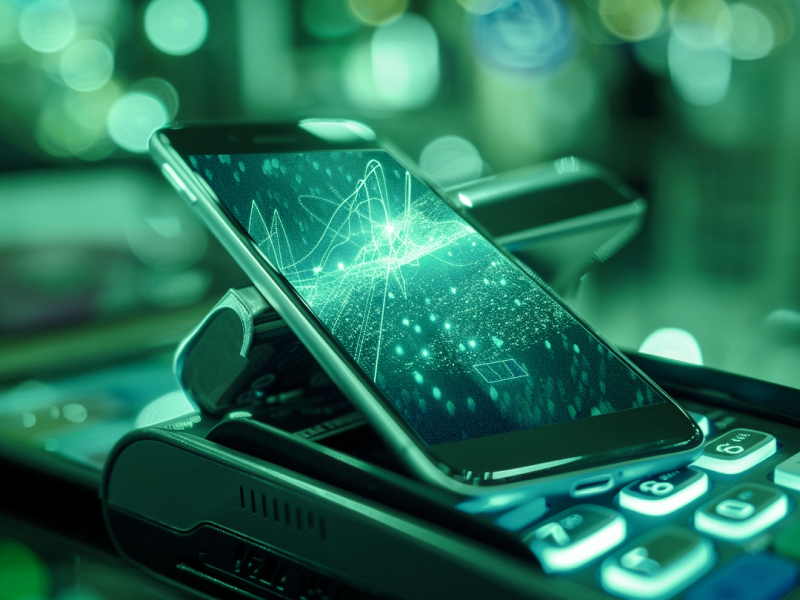The mobile payment industry has witnessed remarkable innovations in recent years, reshaping how consumers make transactions both online and in-store. Digital wallets, blockchain technology, and cryptocurrencies have emerged as key drivers of this transformation, offering users convenient and secure ways to pay for goods and services.
Mobile payments are driving sales across various channels, including eCommerce platforms and physical retail stores. According to industry reports, nearly two-thirds of U.S. smartphone users are expected to use a mobile wallet app to transact monthly in 2024, reflecting a significant increase from previous years. This growing adoption underscores the importance of mobile payments as a preferred payment method for consumers.
Mobile payment trends
Digital wallets have experienced exponential growth in recent years, with more consumers opting for this convenient payment method. Research states that the global digital wallet market is projected to reach $7.6 trillion by 2024, driven by factors such as increased smartphone penetration, rising eCommerce transactions, and growing demand for contactless payments. Digital wallets offer users a secure way to store payment information, make purchases online and in-store, and manage loyalty rewards and coupons, contributing to their widespread adoption.
The intersection of mobile payments with blockchain technology and cryptocurrencies also has the potential to revolutionize the way financial transactions are conducted. Blockchain-based mobile payment systems offer several advantages, including security, reduced transaction fees, and improved transparency. This can be excellently illustrated by blockchain technology that facilitates faster and more secure cross-border transactions, eliminating the need for intermediaries and reducing transaction costs. Cryptocurrencies such as Bitcoin and Ethereum provide users with alternative payment options, allowing for greater financial inclusion and accessibility. As blockchain and cryptocurrencies continue to gain traction, they are expected to play a significant role in shaping the future of mobile payments.
Challenges and solutions
One of the primary challenges facing the mobile payment industry is providing easy and safe transaction processes for users. While mobile payments offer convenience, users expect effortless and secure experiences when making transactions. Any friction or security concerns can deter users from adopting mobile payment solutions. To address this challenge, mobile payment providers must invest in user-friendly interfaces, security measures, and transparent communication to instill trust and confidence among users.
Another challenge is the lack of universal payment solutions that cater to the diverse needs of consumers and merchants. With multiple mobile payment platforms and technologies available, interoperability issues arise, hindering the exchange of funds between different systems. To overcome this challenge, industry stakeholders must collaborate to develop standardized protocols and interoperable solutions that enable seamless transactions across various platforms and ecosystems.
User experience plays a further unsurmountable role in driving adoption and usage of mobile payment solutions. As more consumers shop online and use mobile apps for transactions, businesses must prioritize the design and usability of their mobile shopping apps. An intuitive user experience can massively improve customer satisfaction, increase engagement, and drive conversion rates. Features such as one-click payments, personalized recommendations, and integration with mobile wallets can provide users with a frictionless shopping experience, encouraging repeat purchases and loyalty.
Factors driving mobile payments craze
Influence of pandemic on consumer behavior
The COVID-19 pandemic significantly accelerated the adoption of mobile payments as consumers sought safer and more convenient ways to transact. With restrictions on physical shopping and concerns about virus transmission, consumers turned to mobile payment options for both online and in-store purchases. According to industry reports, the pandemic led to a surge in mobile wallet usage, with a substantial increase in the number of users opting for contactless payment methods to minimize physical contact and reduce the risk of infection.
Role of physical store retailers in adapting to mobile payments
Physical store retailers played a crucial role in driving the adoption of mobile payments by adapting their payment infrastructure to accommodate digital transactions. Recognizing the changing preferences of consumers, many retailers invested in upgrading their point-of-sale (POS) systems to accept mobile payments. This proactive approach catered to the immediate needs of consumers during the pandemic and positioned retailers for long-term success in an increasingly digital marketplace.
Buy Now, Pay Later (BNPL) schemes
The rise of Buy Now, Pay Later (BNPL) schemes further fueled the popularity of mobile payments. These payment solutions allow consumers to make purchases and spread the cost over several installments, often with zero or low-interest fees. BNPL services appeal to consumers seeking greater flexibility and affordability in their purchasing decisions. As a result, many mobile payment platforms have integrated BNPL options, providing users with additional payment choices and driving higher transaction volumes.
Growth of mobile eCommerce sales
The exponential growth of mobile eCommerce sales has been a major driver of the mobile payments craze. With the increasing prevalence of smartphones and mobile devices, consumers are increasingly turning to mobile platforms for their online shopping needs. According to Statista, mobile eCommerce sales reached $2.2 trillion in 2023, accounting for 60% of all eCommerce sales globally. This rapid growth shows the importance of mobile payment solutions in facilitating seamless and secure transactions in the digital marketplace.
ID security
As the world becomes increasingly digital, there has been a notable change towards digital identification (ID) solutions. Digital IDs offer greater convenience, accessibility, and security compared to traditional physical documents. With digital IDs, consumers can securely store and access their identification credentials on their mobile devices, streamlining identity verification processes in various contexts, including banking, shopping, and online transactions.
Mobile ID verification plays a growing role in security and trust in eCommerce transactions. When leveraging mobile technology, retailers can verify the identity of customers more efficiently and effectively, reducing the risk of fraudulent activities such as identity theft and account takeover. Mobile ID verification also helps with frictionless checkout experiences, allowing users to complete transactions quickly and securely without the need for manual documentation or verification processes.
Platforms like IDscan for combating digital fraud
Platforms like IDScan play an ever growing role in combating digital fraud by providing advanced ID verification solutions. These platforms make use of cutting-edge technologies such as artificial intelligence (AI) and machine learning to authenticate digital IDs and detect fraudulent activities in real-time. When integrating IDScan’s platform into their systems, retailers can strengthen their fraud prevention measures, safeguard sensitive customer data, and boost the overall security of their eCommerce operations. This proactive approach protects businesses from financial losses while preserving consumer trust and confidence in the integrity of online transactions.
Scan-free transactions
Challenges with scan-free checkouts
Scan-free checkouts, once hailed as a promising innovation in retail, faced significant challenges in implementation. One of the primary issues was the reliance on self-checkout systems, which often led to logistical challenges and errors. Consumers reported instances of missed scans on products or encountered difficulties with faulty scanning equipment. This resulted in revenue losses for vendors and dissatisfaction among shoppers due to longer waiting times and potential disputes over scanned items.
There was growing distrust among consumers regarding the reliability and integrity of scan-free systems. Many shoppers were hesitant to embrace the concept of self-checkout, expressing concerns over potential errors in scanning or deliberate attempts at theft. This highlighted the need for a more reliable and seamless checkout experience that could still maintain trust and security.
Emergence of RFID-based automatic scanning
To address the shortcomings of traditional scan-free checkouts, the retail industry witnessed the emergence of RFID-based automatic scanning solutions. RFID (Radio-Frequency Identification) technology allows for automatic identification and tracking of tags attached to objects, providing efficient and accurate inventory management and checkout processes.
With RFID-based systems, retailers can implement automatic scanning capabilities within shopping carts or overhead sensors. As consumers place items in their carts, RFID sensors automatically detect and register the products, eliminating the need for manual scanning at checkout counters. This simplifies the checkout process while also reducing the likelihood of errors and discrepancies in scanned items.
Key takeaways
The mobile payment industry will continue to experience rapid innovation and transformation, driven by advancements in technology, changing consumer behaviors, and new regulations. From the rise of digital wallets and blockchain-based payment systems to the adoption of scan-free transactions and mobile ID verification, the industry is undergoing profound changes that are reshaping the way businesses and consumers interact.
For businesses, embracing mobile payment solutions and staying abreast of emerging trends is crucial for remaining competitive and meeting the evolving needs of customers. By providing secure payment experiences, retailers can increase customer satisfaction, drive sales, and build long-term loyalty.
For consumers, the proliferation of mobile payment options offers greater convenience, flexibility, and security in their everyday transactions. From financing options to buy-now-pay-later schemes, consumers have more choices than ever before, enabling them to make purchases on their own terms.
Looking ahead, the future of the mobile payment industry is promising, with continued innovation expected to drive further growth and expansion. As technology continues to develop and consumer preferences evolve, businesses must adapt and innovate to stay ahead of the curve and capitalize on emerging opportunities in the dynamic landscape of mobile payments.





